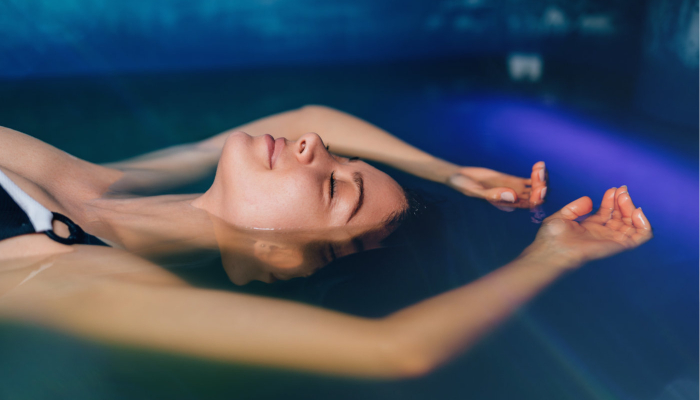By Guest Blogger Tracy Huneycutt
Since turning 40 over three years ago, I began a personal health and wellness journey. My initial goal was to learn how to finally lose weight and keep it off for good. Yet, as I began to research and learn more about comprehensive health, my journey took me down new and interesting roads.
In addition to making lifestyle changes, eating more natural and healthier foods, and making exercise an integral part of my weekly routine, I have researched and tested more holistic health practices over the last three years. This is especially beneficial for me as I have entered perimenopause. The hormonal changes during this season of life bring about a new set of challenges, including mood swings, difficulty sleeping, as well as body muscle aches.
One of the holistic health practices I have researched recently is floatation therapy. Floatation tanks, or sensory deprivation tanks, were initially used by scientists in the 1950s, and have seen a resurgence of use over the last two decades as health experts have discovered their many benefits. Even though I was interested in trying a floating session to help with my perimenopausal symptoms, many others can reap the benefits from a float therapy experience as well.
Float therapy sessions have been proven to reduce stress, anxiety & depression, minimize headaches and arthritis, reduce blood pressure, and improve one’s quality of sleep. Spending time in a floating tank activates what’s called the parasympathetic nervous system, which is the body’s natural mechanism for healing and revitalization that operates during periods of deep relaxation. Inducing this process is beneficial for one’s immune system and physical health.
I researched and reviewed websites of natural spas in my vicinity and booked an appointment online. I read up on what to expect before, during, and after my session. It is not advised that women who are pregnant or on their menstrual cycle, individuals with high or low blood pressure, individuals with any significant cuts or wounds, or individuals under the influence of any drugs or alcohol use the tank. The spa I went to required that I shower off with a special shampoo/soap before my session, and that I enter the tank without any clothes (in order to not contaminate the tank in any way.)
A floatation tank is a lightless, soundless tank filled with highly concentrated Epsom salt water heated to skin temperature. You can choose to have the lights on or off and choose to have relaxing music playing or have complete quiet, depending on your personal preference. Wearing a brand-new set of earplugs (which the spa provided) is also required, in order to not have salt water enter your ear canal and potentially cause infection.
I have mild claustrophobia, and I was initially worried that I would feel “trapped” within the floatation pod, but that was not the case. The pod is long (I am 5’8” tall and had plenty of room,) and the top of the pod is relatively high. Upon entering the tank and laying down, you will immediately begin to float due to the high volume of salt in the water. I was provided with a light, circular floatation device to rest my head on, for extra buoyancy.
As someone with a Type-A personality, learning how to shut off my thoughts during times of relaxation was difficult. For the first twenty minutes of my session, I tried to get comfortable. They gave me a small towel to keep on a handle inside the pod, in case I needed to wipe my face (I learned the hard way not to touch near your eyes with salt water covered hands!) I kept trying to fight against the natural flow of my body in still water by remaining towards the center of the pod, but I finally allowed myself to float around as my body saw fit, even if I gently bumped into the sides of the tank. During the middle twenty minutes of my session, I allowed myself to fully relax. I could feel my muscle tension easing, and I spent periods of time stretching out my arms and legs in the tank. I allowed myself to think about how our bodies are never fully weightless like this – we are always lying, sitting, or standing, with gravity pulling us towards what we use for support.
During the last twenty minutes of my session, I began to get a bit restless, and all my thoughts came back (but again, that is customary with my personality.) When my session was near its close, I sat up in the tank for a bit to allow myself to readjust to gravity before getting out. I showered off one more time before dressing to leave.
In the time that followed, I experienced a 24-hour detoxification process, I slept more soundly, and I did not notice as many body aches as I had experienced before my session. I would like to try floatation therapy again soon with the goal of relaxing my mind more now that I know what to expect from start to finish.
As mothers, we often prioritize the needs of others before carving out time for ourselves. Whether it is trying a floatation therapy session or another holistic health and wellness practice, I hope that fellow moms will find ways to nurture their minds, bodies, and spirits.
Want to see more blogs like this and also get notifications on local events and happenings? Subscribe to our free weekly newsletters here.














